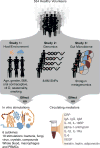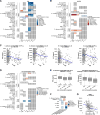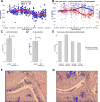Host and Environmental Factors Influencing Individual Human Cytokine Responses
- PMID: 27814508
- PMCID: PMC5787854
- DOI: 10.1016/j.cell.2016.10.018
Host and Environmental Factors Influencing Individual Human Cytokine Responses
Abstract
Differences in susceptibility to immune-mediated diseases are determined by variability in immune responses. In three studies within the Human Functional Genomics Project, we assessed the effect of environmental and non-genetic host factors of the genetic make-up of the host and of the intestinal microbiome on the cytokine responses in humans. We analyzed the association of these factors with circulating mediators and with six cytokines after stimulation with 19 bacterial, fungal, viral, and non-microbial metabolic stimuli in 534 healthy subjects. In this first study, we show a strong impact of non-genetic host factors (e.g., age and gender) on cytokine production and circulating mediators. Additionally, annual seasonality is found to be an important environmental factor influencing cytokine production. Alpha-1-antitrypsin concentrations partially mediate the seasonality of cytokine responses, whereas the effect of vitamin D levels is limited. The complete dataset has been made publicly available as a comprehensive resource for future studies. PAPERCLIP.
Keywords: age; alpha-1-antitrypsin; cytokines; environment; gender; genetics; host; microbiome; season; vitamin D.
Copyright © 2016 Elsevier Inc. All rights reserved.
Figures






Comment in
-
The Human Functional Genomics Project: Understanding Generation of Diversity.Cell. 2016 Nov 3;167(4):894-896. doi: 10.1016/j.cell.2016.10.040. Cell. 2016. PMID: 27814519
References
-
- Anderson P. Post-transcriptional control of cytokine production. Nat Immunol. 2008;9:353–359. - PubMed
-
- Aulock SV, Deininger S, Draing C, Gueinzius K, Dehus O, Hermann C. Gender difference in cytokine secretion on immune stimulation with LPS and LTA. Journal of interferon & cytokine research: the official journal of the International Society for Interferon and Cytokine Research. 2006;26:887–892. - PubMed
-
- Behre HM, Simoni M, Nieschlag E. Strong association between serum levels of leptin and testosterone in men. Clinical endocrinology. 1997;47:237–240. - PubMed
Publication types
MeSH terms
Substances
Grants and funding
LinkOut - more resources
Full Text Sources
Other Literature Sources

